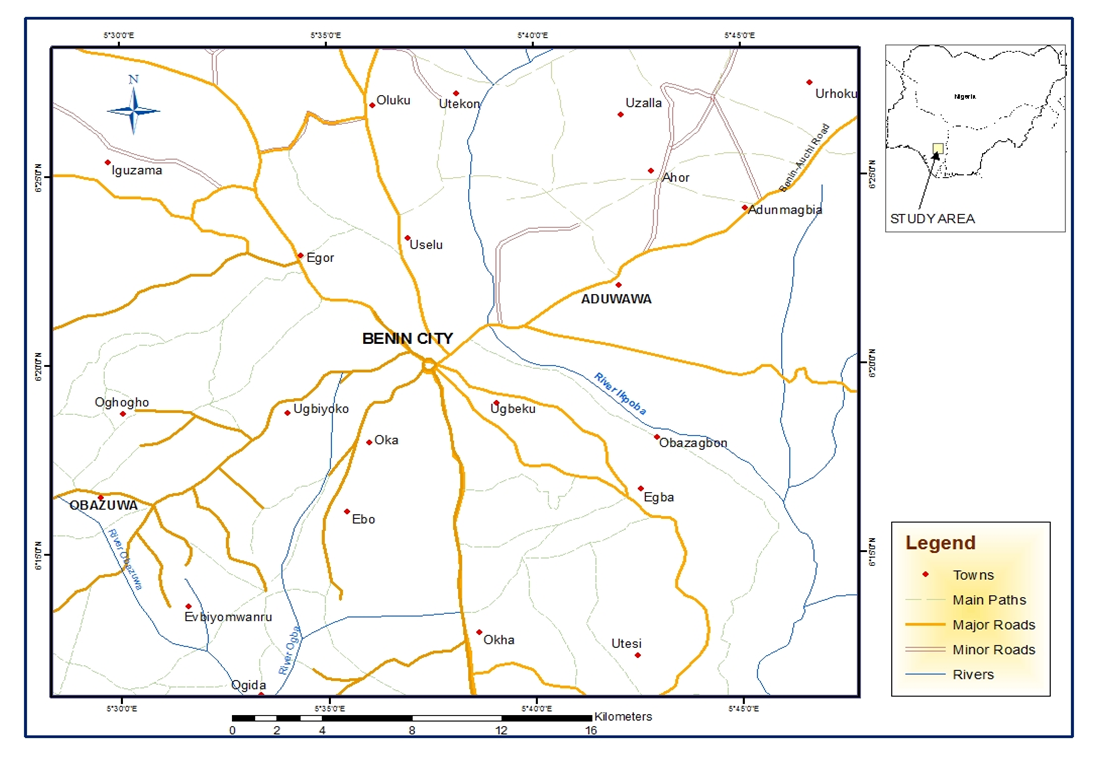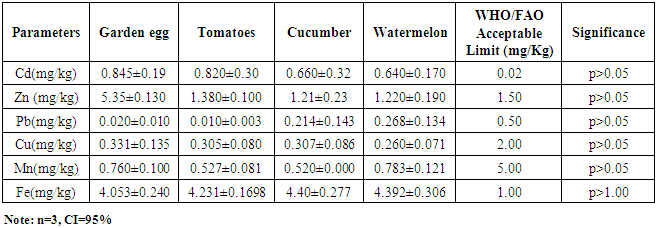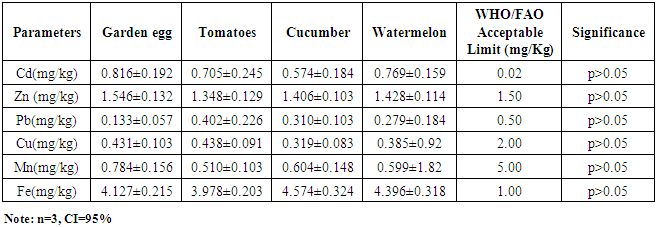-
Paper Information
- Paper Submission
-
Journal Information
- About This Journal
- Editorial Board
- Current Issue
- Archive
- Author Guidelines
- Contact Us
Food and Public Health
p-ISSN: 2162-9412 e-ISSN: 2162-8440
2020; 10(3): 63-67
doi:10.5923/j.fph.20201003.01
Received: June 30, 2020; Accepted: July 31, 2020; Published: August 15, 2020

Occurrence and Concentration of Heavy Metals in Garden Egg, Tomatoes, Cucumber and Watermelon from Two Major Markets in Edo State, Nigeria
Vincent Oyareme 1, Samuel E. Akpogheneta 2, B. N. Iloba 2, Friday Ogidiagba 3
1Environmental (Option) in SAES, University of The Gambia (UTG), Gambia
2Department of Animal and Environmental Biology, Faculty of Life Sciences, University of Benin, Benin City, Edo State, Nigeria
3Bayelsa State College of Health Technology, Otuogidi, Ogbia Town, Bayelsa State, Nigeria
Correspondence to: Vincent Oyareme , Environmental (Option) in SAES, University of The Gambia (UTG), Gambia.
| Email: |  |
Copyright © 2020 The Author(s). Published by Scientific & Academic Publishing.
This work is licensed under the Creative Commons Attribution International License (CC BY).
http://creativecommons.org/licenses/by/4.0/

This study was conducted to analyze the concentration of some heavy metals in selected vegetable fruits sold in Uselu and Ologbo markets. Using Atomic Absorption Spectrophotometry (AAS) the heavy metal concentration of Cd, Zn, Pb, Cu, Mn, Fe, Co, Cr Ni in Watermelon, Garden Egg, Tomato and Cucumber was studied. Trace element as Fe and Zn showed high concentration occurrence. The heavy metal concentration of Fe in Cucumber and watermelon from both markets was found to be 4.57 ± 0.32mg/kg and 4.39 ± 0.32 mg/kg respectively exceeding the permissible limit of food and agricultural organization and world health organization. Pb recorded the lowest value of 0.13 ± 0.09mg/kg in garden egg and 0. 28 ± 0.18mg/kg in watermelon, Analysis of Variance (ANOVA) showed a significant difference (P < 0.05) in the concentration of heavy metals (Fe, Pb, Cd, Mn, Cu, and Zn) in both stations. Fruits sample used for the study is contaminated with Fe and Zn which serves as a serious health concern.
Keywords: Heavy metals, Fruits, Health risk, WHO limits, Contamination, Permissible limits
Cite this paper: Vincent Oyareme , Samuel E. Akpogheneta , B. N. Iloba , Friday Ogidiagba , Occurrence and Concentration of Heavy Metals in Garden Egg, Tomatoes, Cucumber and Watermelon from Two Major Markets in Edo State, Nigeria, Food and Public Health, Vol. 10 No. 3, 2020, pp. 63-67. doi: 10.5923/j.fph.20201003.01.
1. Introduction
- Compared to water, heavy metals are elements with relatively high density. With the belief that there exists a relationship between heaviness and toxicity, metalloids such as arsenic, which can induce toxicity at a low level of exposure can also be regarded as heavy metal (Wang et al., 2007). There has been increased ecological and public health concerns globally linked to heavy metal contamination of recent. There has been increased human exposure due to its increased industrial, agricultural, domestic and technological applications. Reported sources of heavy metals in the environment include industrial, agricultural, pharmaceutical, domestic wastes, and atmospheric sources. Dogheim and Alla, (2004) reported agricultural, domestic wastes, industrial discharges, pharmaceutical, cosmetics and atmospheric sources as the main source of heavy metals in the environment. Environmental pollution is common in point source areas such as mining, foundries and smelters and other metal-based industrial operation (Hawkens, 1997). Although heavy metals are naturally occurring elements found throughout the earth’s crust, most environmental contamination and human exposure arise from human activities such as mining and smelting operations, industrial production and use, and domestic activities such as mining operations, domestic and agricultural use by metals and metal-containing compound (Jamali et al., 2007). Environmental contamination can also occur through metal corrosion atmospheric deposition, soil erosion of metal ions and leaching of heavy metals, sediment resuspension and metal evaporate from water source to soil and groundwater. Natural phenomena such as weathering, tsunamis and volcanic eruption have also been reported to significantly contribute to heavy metal pollution in the environment. Other sources of heavy metal pollutions are industrial sources such as metal processing in refineries, coal burning in power plants, petroleum combustion, nuclear power stations and high-tension lines, plastics, textiles microelectronics, wood preservation and paper processing plant. Heavy metal can enter into the human body through inhalation, ingestion and dermal contact absorption (Adelekan and Abegunde, 2011; Rajaganapathy et al., 2011). They also accumulate in soils, plants and aquatic biota (Obodai et al., 2011; Wuana and Okieimen, 2011).The aim of this work is therefore to determine the heavy metal concentration in fruits from two major markets in Edo State, Nigeria if these fruits are safe for human consumption.
2. Materials and Methods
- This study was carried out in Uselu and Ologbo market located in Benin City, Edo State, southwestern Nigeria (Figure 1) which has Latitude of 6° 20' 21.0660'' N and Longitude of 5° 37' 2.8092'' E.
 | Figure 1. Map of Study Location |
3. Result and Discussion
- Tables 1 and 2 show the concentrations of heavy metals in fruits frequently consumed in Edo State, Nigeria. The values are given as mean ± SE and the results are means of three replicates. The heavy metal concentration is determined based on plants' dry weight. Heavy metals affect the nutritive contents of agricultural products and also have a harmful effect on humans. National and international regulations on food quality set the maximum permissible limit of toxic metals in human food; hence an essential aspect of food quality should be to regulate the concentrations of heavy metals in food (Radwan and Salama, 2006; Sobukola et al., 2008).Cadmium is a non-essential element in foods and natural waters and primarily it accumulates in the kidneys and liver (Divrikli et al., 2006). In all the samples analyzed from the two markets, the concentration was observed to be above the permissible limit of 0.02 mg/kg as reported by WHO (2001), which might be a treat for human consumption. It was highest in garden egg with a value of 0.820 mg/kg and 0.705 mg/kg respectively and lowest in watermelon and cucumber with a value of 0.640mg/kg and 0.574mg/kg respectively.Al Jassir et al. (2005) reported that levels of Cd were higher in the garden rocket vegetable species for both washed and unwashed samples.Zinc is one of the most essential metals for normal growth and development in humans (Divrikli et al., 2006). Zinc deficiency is of growing concern in developing countries. In these countries, Zinc deficiencies have been attributed to the large consumption of bread made without yeast (Divrikli et al., 2006). Excess Zinc can also be harmful, and cause Zinc toxicity. Such toxicity levels have been seen to occur at ingestion greater than 225mg/kg of Zinc. The concentration of Zinc in all the samples analyzed from the two markets (Table 1 and 2), was observed to be below the WHO permissible limit of 1.50mg/kg as reported by WHO (2001) except for garden egg with a higher value of 5.35 and 1.546 mg/kg respectively. Kihampa et al. (2011) reported a high Zinc concentration ranging between 18.16 and 122.88mg/kg in Amaranthus species. Radwan and Salama (2006) and Onianwe et al. (2001) have also reported Zn levels of 5.35 and 7.40 mg/kg; 2.38 and 2.20 mg/kg; as well as 5.59 and 1.50 mg/kg for watermelon, orange and banana, respectively. Zinc (Zn) accumulation in high amounts can cause eminent health problems, such as stomach cramp, skin irritation, vomiting, nausea and anemia (Wuana and Okieimen, 2011).
|
|
4. Conclusions
- The result of this study showed that the four analyzed edible fruits commonly consumed by people in Edo state, from the two different markets, were contaminated with different levels of heavy metals. The results also revealed that the heavy metal concentration of some of the fruits analyzed was higher than WHO acceptable limits which can pose a serious health challenge while some are below the limit making them suitable for human consumption.
 Abstract
Abstract Reference
Reference Full-Text PDF
Full-Text PDF Full-text HTML
Full-text HTML
